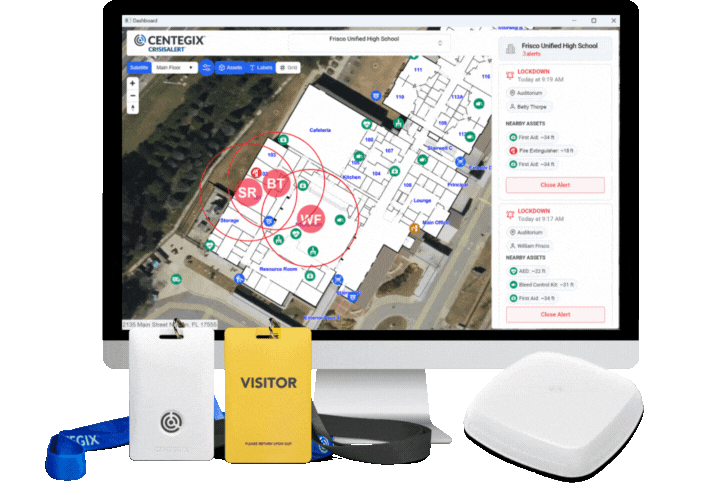To minimize communication failures, hospitals should implement workplace violence safety plans that focus specifically on the effectiveness and speed of communication among employees. Plans incorporating a wearable emergency button are especially good at keeping employees in constant communication. A campus-wide communication solution that generates useful data for administrators can be instrumental in improving communication among staff members and departments.
In a busy healthcare environment, communication errors are inevitable. Patients often interact with many different providers, many of whom are not in direct contact with one another. The constantly changing clinical conditions can often lead to lapses in communication, even when excellent medical care is being provided. Hospitals need effective communication systems to prevent information from slipping through the cracks. After all, the consequences of communication errors can be devastating; when providers are unaware of critical information, complications or even death may result.
Consequences of Communication Failures

Workplace violence safety plan
According to Joint Commission International, “effective communication between healthcare providers and patients and their families is essential to safe, quality care.” Conversely, and tragically, poor communication between providers and patients can lead to patient harm or even death. Common breakdowns in communication include
- miscommunication about a patient’s condition
- inadequate informed consent
- poor documentation
- unsympathetic response to a patient’s complaint
Each of these breakdowns leads to undesirable outcomes for both patient care and caregiver safety. For example, when information is poorly communicated during a patient handover, a nurse coming onto shift may provide care and dispense medication based on old or incorrect information. This increases the likelihood of complications. The patient’s resulting anger or aggression may put the nurse in harm’s way. Poor patient care and highly stressed caregivers, in turn, negatively affect a hospital’s profitability. Workplace violence has been shown to negatively impact caregiver job satisfaction and performance. Healthcare workers need to feel safe to ensure a hospital’s financial success.
Medical malpractice suits in response to communication errors also damage a healthcare system’s bottom line. Communication failures are the underlying cause of many medical malpractice lawsuits. One study of 23,000 malpractice lawsuits found that 7,000 of those could be attributed to communication failures. The patients behind these lawsuits suffer complications or other consequences, including 2,000 preventable deaths. The result: $1.7 billion in malpractice costs.
Why Does Communication Break Down?

Workplace violence safety plan
Many healthcare systems continue to use outdated technology to facilitate communication among caregivers. Though medical technology has advanced exponentially over the last two decades, many hospitals are using the same clinical communication technologies now as they did during the 1990s. Many caregivers must utilize some combination of pagers, flip phones, intercoms, smartphones, and other department-wide communication systems. Especially in this era of staff shortages and hiring difficulties, providers are often exceptionally busy throughout their shifts. They cannot always respond to phone calls or pages immediately. In a medical environment where timeliness can be a critical factor in a patient’s well-being, these lapses can be dangerous.
Intercoms present additional challenges. When a call goes out over an intercom system, a busy provider may assume that someone else will respond. If everyone on the floor is occupied, this creates a lapse in care. When a provider cannot hear and respond to intercom communication, their ability to respond is delayed. Poor patient care results.
Alarm Fatigue Contributes to Communication Failures
In a medical setting, an alarm is a notification or sound from a medical device—typically located at a patient’s bedside—that indicates a potentially life-threatening condition that requires immediate staff attention. Unfortunately, on busy hospital floors, alarms can be so frequent that providers become inured to them. The use of electronic monitoring in patient care areas creates a syndrome of “alarm fatigue:” the constant drone of beeps and buzzes, and false alarms in between, can leave healthcare providers desensitized and in danger of missing the next alarm. The sensory overload associated with alarm fatigue can lead to missed alarms, which can result in patient deaths. A different mode of communication—one that doesn’t add to the cacophony of beeps—is needed to ensure that providers respond quickly and that patients receive the best possible care.
Alarms vs. Alerts: Use Wearable Emergency Buttons for Communication
The source of an alarm is the patient, whereas the source of an alert is the staff. An alert occurs when a staff member indicates a need for support or provides other information that decision-makers can use to inform their policies. For example, a workplace violence safety plan should be formulated in response to incidents of violence as reported by staff members. By viewing the data set that results from staff alerts, administrators can direct additional personnel to locations where workplace violence commonly occurs, or increase staffing at specific times. Staff alert data provides valuable information to administrators as they seek to improve patient care and caregiver safety.
Wearable emergency buttons enable staff members to alert other staff instantly. A wearable badge also facilitates high percentages of user adoption. Whereas other, more difficult-to-use technologies may lead to communication failures, a wearable emergency button is simple. It never gets forgotten at a nurse’s station, doesn’t require a caregiver to leave a patient to use the telephone, and doesn’t contribute to the problem of alarm fatigue.
CENTEGIX CrisisAlert Keeps Staff Safe and Improves Patient Care
CENTEGIX’s CrisisAlert system makes communication failures visible to administrators and provides data that allows them to make improvements. CrisisAlert’s wearable emergency button facilitates easy and instant duress communication, creating a culture of safety and protecting staff. The CrisisAlert system also collects data about where problems occur. As a result, hospitals can improve response time and allocate resources where they are most needed. For example, staff alerts may indicate that incidents of violence occur most often during shift changes. In this event, administrators may increase staffing during those times, or provide training that mitigates patient agitation during shift changes.
To prevent communication failures, hospitals need effective communication systems that integrate seamlessly with their existing technology and feature a wearable emergency button. Any system that further complicates a facility’s IT network is already at risk of communication errors, glitches, and low user adoption rates. New technology may offer great benefits, but its value can only be realized if it fits into a hospital’s existing system and is adopted by a majority of staff. The CENTEGIX CrisisAlert system runs over its own network. Its system can therefore operate without being integrated into a facility’s existing system. CrisisAlert’s powerful analytics engine captures incident data, providing the information needed to identify and track trends and identify other measures to increase safety and security. CrisisAlert produces high-quality information for decision-makers, improves communication in busy healthcare settings, and improves both patient and caregiver safety.
CENTEGIX® is the industry leader and largest wearable safety technology provider with over 600,000 badges in use. The cloud-based CENTEGIX Safety Platform™ initiates the fastest response time for emergencies campus-wide. Leaders in over 11,500 locations nationwide trust CENTEGIX’s innovative safety solutions to empower and protect people every day.










